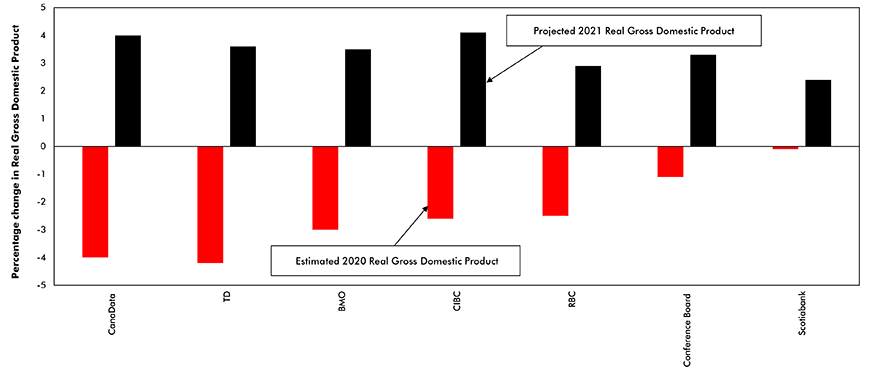If, ahead of the onslaught of COVID-19, the world economy in general and the Canadian economy specifically had been in excellent health (i.e., with strong immune systems), its impact would have been less severe over the past several weeks.
Globally, the OECD’s composite leading indicator has been trending lower since early 2018. Consistent with the deterioration in this forward-looking economic indicator, the pace of quarter-over-quarter real economic activity in the OECD slowed from 0.4% to 0.2% in the final quarter of 2019, its smallest quarterly gain since early 2016.
Against this deteriorating external economic climate, the health of the Canadian economy was further compromised by an extended rail blockade which severely restricted the country’s east-west flow of goods and reduced first-quarter growth by an estimated 0.2% to 0.3%, equivalent to the overall gain in the final quarter of 2019.
Layoffs and hiring freeze cause record rise in employment insurance claims
Given the unprecedented lockdowns of major sectors of both the Canadian and U.S. economies to limit the spread of the COVID-19 virus and the uncertainty about its duration, it is impossible to precisely estimate the impact on the economy in the near term. Despite the addition of 64,000 jobs in the first two months of the year, several indicators point to a sharp contraction in Q1.
First, employment insurance claims jumped by 1,500,000 in the week ending March 25. Second, according to the Canadian Federation of Independent Business, short-term hiring plans in the country evaporated in March. Third, consumer confidence as reported by the Conference Board of Canada dropped by an unprecedented 32 points in March while the Royal Bank’s Business Barometer hit a ten-year low. Based on these mostly-coincident measures of economic activity, we estimate the economy contracted by close to 5% at annual rate in Q1.
Expect a sharp contraction in second quarter
How we will do in Q2 is a coin toss given the pervasive climate of uncertainty which has paralyzed economic activity in much of Canada and the U.S. and sidelined so many workers. Hopefully this paralysis will, in part, be offset by unprecedented fiscal stimulus simultaneously announced in both countries.
In Canada, the government announced it will give $2,000 every four weeks to workers laid off due to COVID-19. Since it will take time to deliver this stimulus, consumer spending (which accounts for 56% of total spending) will bear the brunt of a sharp contraction in earned income and an accompanying drop in buying plans. Spending on durables will be particularly hard hit as housebound consumers temporarily postpone discretionary purchases such as autos, appliances, and home furnishings. Pent-up demand, a pickup in hiring and income growth should bring consumers back to shopping malls in increasing numbers in the second half.
Housing market will stall in April and not re-start until June or July
There is clear evidence that the combination of the unprecedented increase in joblessness and the impact of efforts to contain COVID-19 has caused demand to retreat sharply in Canada’s largest housing markets. However, the already tight conditions in most major markets and the likelihood that those planning to put their homes up for sale will probably hold off until the effects of COVID-19 dissipate should help limit the downward pressure on prices.
Weighed down by uncertainty about the potential spread of COVID-19 and the effects of persisting self-isolation, many major residential builders appear to have put their operations on hold in March. In light of this development, we expect total residential construction to contract sharply in April and remain depressed in May. Going forward, a rebound in confidence, coupled with pent-up demand, should re-ignite the housing market in the second half of this year and continue to support its growth in 2021.
Drop in private sector CAPEX should be offset in part by public sector spending
Our thoughts about the outlook for non-residential capital spending are presented in the previous snapshot titled “Political uncertainty and coronavirus darken the outlook for non-res construction”. While the negative outlook for private sector capital spending outlined in that snapshot was reinforced by CFIB’s March Business Barometer, we continue to expect public sector spending plans to remain largely intact based on provincial budgets released year to date. This outlook is reinforced by Ontario’s recently announced decision to shut down private sector non-residential construction projects in the province, while exempting public sector project and some residential work.
We expect the economy to shrink by 4% this year and rebound in 2021
Guesses about how much the economy will contract this year are all over the map. Among the major banks, they range from Toronto Dominion’s projection of -4.2% (a post-World War 2 low) to Bank of Nova Scotia’s relatively mild dip of -0.1%. Given the above-noted unprecedented contraction in economic activity in the first half and assuming the impact of the virus does not persist beyond mid-year, we expect overall growth to contract by -3% to -5% in 2020 and to rebound by about the same percentage in 2021.
John Clinkard has over 35 years’ experience as an economist in international, national and regional research and analysis with leading financial institutions and media outlets in Canada.
Comparison of Forecasts of Canadian Real Gross Domestic Product for 2020 and 2021

Conference Board of Canada, Bank of Nova Scotia.
Chart: ConstructConnect — CanaData.











Recent Comments
comments for this post are closed